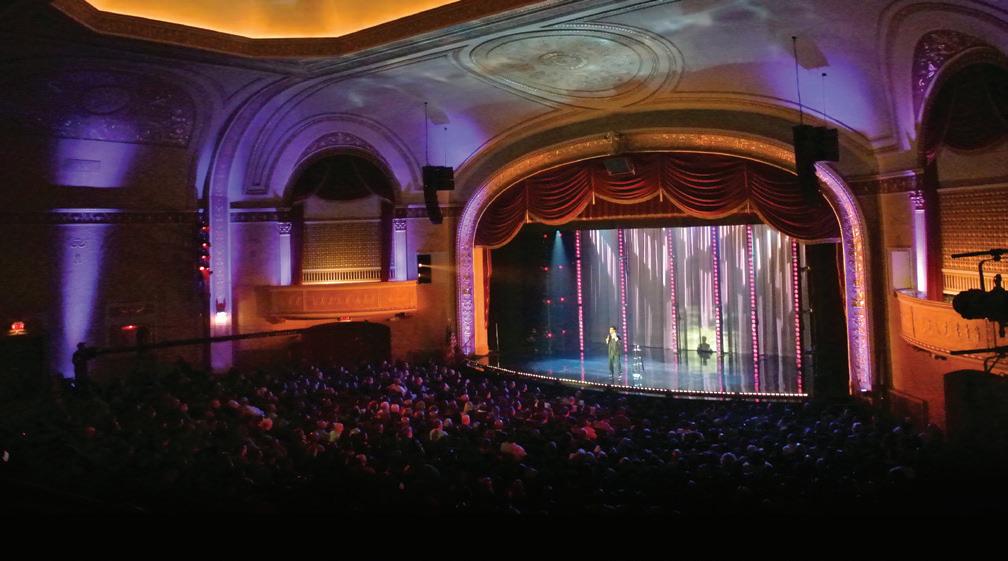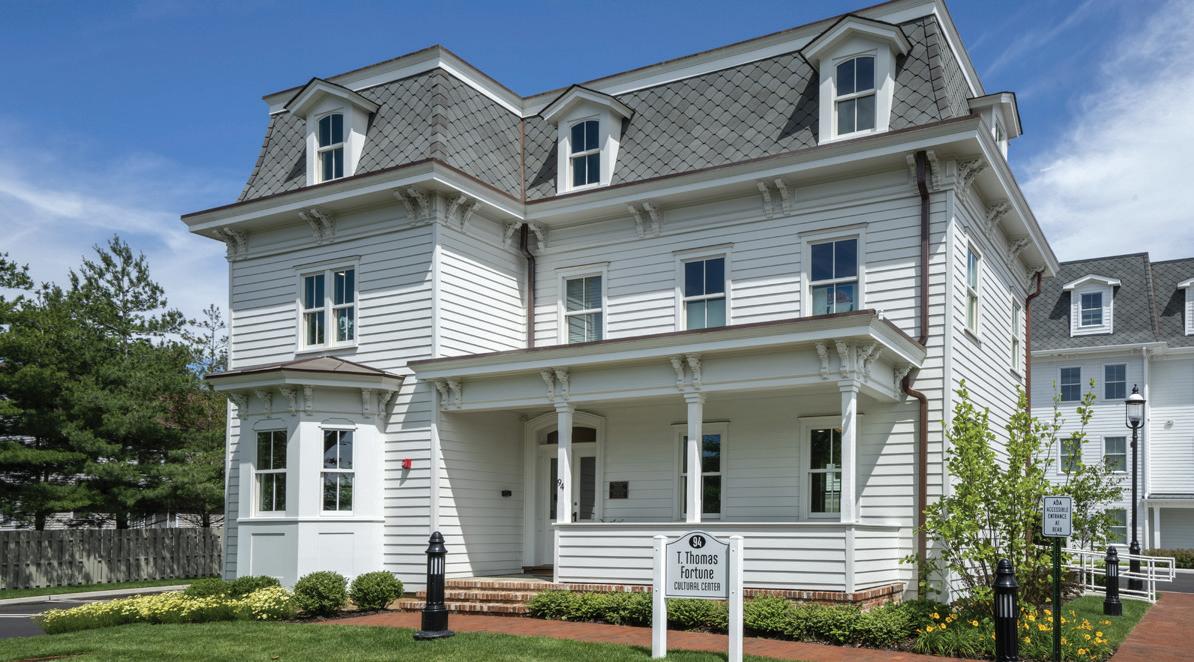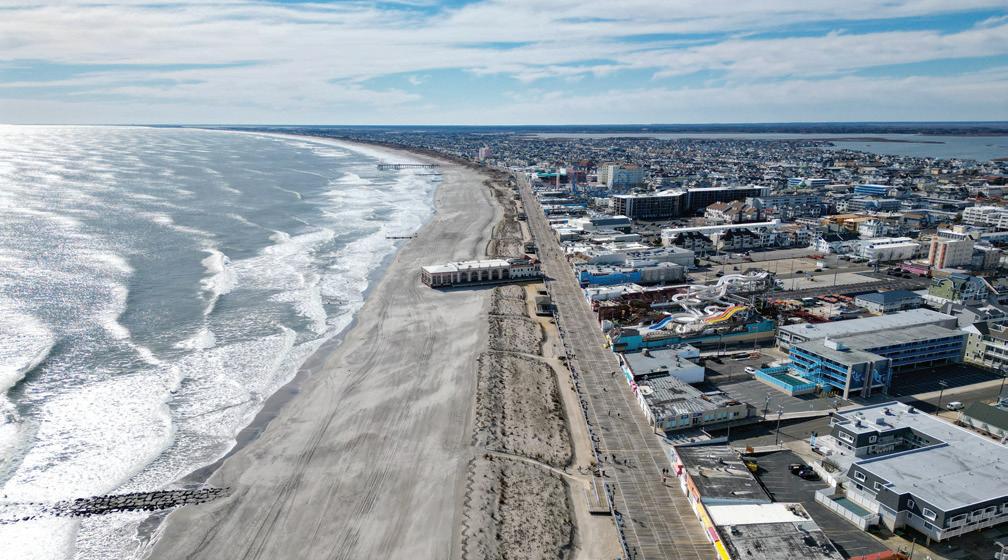
9 minute read
NJ Arts Take Center Stage
BY MICHELE LERNER
Communities Connected by Culture and Amenities
Mention New Jersey to people from out-of-state and they’ll smile with fond memories of a beach vacation in Ocean City or an antiquing weekend in Cape May. But locals know every community throughout the state has its own culture— whether it’s a college town, a seaside village or a trendy downtown neighborhood with performing arts spaces, music festivals and art venues. Realtors® can help buyers explore communities and make the connection between the local culture, their lifestyle, and the potential impact on home values.
“Cultural spots like art galleries, theaters and museums add a layer of personality and energy to a neighborhood,” said Woo Kim, founder of LynkMe Cards, a digital business card company. “They make an area feel alive and interesting. I’ve noticed that younger buyers and even downsizing boomers are especially drawn to places where there’s always something to do or explore—it’s not just about the house, it’s about the lifestyle.”
Many people who move to New Jersey, especially from New York City, look to replicate the diverse culture they experience in cities, said Kelly Raggio, broker/owner and Realtor® of RE/MAX Central Manalapan.
“People like to move to places like Red Bank, Princeton and Westfield where they can walk to restaurants, art galleries and performing arts venues along with parks,” said Raggio. “They want a quaint meets cosmopolitan lifestyle, and these towns deliver that.”


Community and Culture Create Value
For Realtors®, community features can be great talking points, said Kim.
“Instead of just listing the number of bedrooms and bathrooms, Realtors® can paint a picture, such as ‘You’re a five-minute walk from live jazz on Friday nights or ‘steps from weekend art markets’,” said Kim. “It helps buyers connect emotionally, and that connection goes a long way in closing deals.”
In addition, Kim recommends Realtors® and other community members actively highlight their cultural scene.
“Start small and local—showcase artists, host pop-up events, highlight murals or historic landmarks,” said Kim. “Even something as simple as including a local art walk or live music night in city newsletters or on social media helps build that identity.”
Community leaders may want to invest in enhancing cultural amenities in their town for economic development and to maintain real estate values.
According to the Central Oregon Business News, “The presence of well-established or emerging cultural districts within a city signals a strong, community-focused area with growth potential, appealing to both residential buyers and commercial investors. These areas typically maintain their value and can even thrive in economic downturns, as the cultural sector often remains a draw for tourism and local patronage.”
Kim agrees.
“Homes in areas with a strong cultural vibe tend to hold their value better and attract more interest,” said Kim. “Buyers feel like they’re getting more than just a home—they’re buying into a community experience.”
Development can be jumpstarted in communities where artists have been encouraged to move through financial incentives or where live-work spaces have been built to attract artists, said Humberto Diaz, a Realtor® with Coldwell Banker Realty in Hoboken.
“Property values often increase the fastest around places with art galleries, museums and performing arts venues, such as in Newark near the Prudential Center and the New Jersey Performing Arts Center,” said Diaz. “A lot of buyers in Union County and Hudson County come from New York City, Queens and Brooklyn, so it’s a selling point to show them there’s an arts scene here and that it’s not a suburban area with nothing to do.”
Cultural Hotspots
While nearly every town has a local landmark, a few cities and towns stand out for their cultural amenities, such as:
• Hoboken. Washington Street in Hoboken features bars and boutiques, with nearby art galleries. In the spring and the fall, the Hoboken Arts and Music Festival brings together artists and performers. “Since the 1980s there’s been a large artist community in Hoboken that’s brought artists in from New York and other areas to live there,” said Diaz.
• Jersey City. Since 2004, when the city offered livework spaces to artists through a lottery system, art has infused the city, said Diaz. There’s an annual artist’s walk where people can visit open studios, plus murals have been added to buildings and traffic lights around the city.
• Newark. Museums, art galleries and performing arts venues add to the culture in New Jersey’s largest city.
• Princeton. In addition to the museum and performing arts venues affiliated with Princeton University, there are art galleries, shops, restaurants and other cultural amenities within the town’s walkable downtown, said Raggio.
• Red Bank. A quaint town known for its art scene and live music located less than 10 miles from the Jersey shore and with a ferry to New York City.
Beach Town Culture
Buyers dreaming of a beach home come for the sandy shoreline, but each town has its own nuance and culture, said Jeff Quintin, a Realtor® with eXp Realty in Ocean City.
“Ocean City has the Ocean City Music Pier for summer concerts, lots of festivals and is a family-oriented dry community with no bars or liquor stores,” Quintin said. “A couple of towns over, Margate is more adult-oriented with bars, entertainment venues and casinos in nearby Atlantic City. Cape May has its historic homes, art galleries and is quaint, with good restaurants.”
Sea Isle City, Quintin said, is a “full-on party town” with more short-term vacation rentals and beach bars.
“The Wildwoods have tons of festivals and events, including the Barefoot Country Music Festival and Monster Truck Jams, plus a boardwalk for families,” he said. “Other towns like Avalon and Stone Harbor have luxury homes, high-end restaurants and a more chill beach vibe.”

New Jersey’s Cultural Institutions to Explore:
Performing Arts Venues
• New Jersey Performing Arts Center in Newark. In addition to performances, the organization provides educational and cultural events throughout the city.
• Prudential Center in Newark. In addition to sports, this venue offers a calendar of concerts, comedy shows, family events, and more.
• Richardson Auditorium in Princeton. This venue hosts a variety of concerts, including the Princeton Symphony Orchestra, as well as lectures by public figures and more than 200 theatrical performances annually.
• The Count Basie Center for the Arts in Red Bank. A performing arts center named after jazz legend William “Count” Basie.
• Two River Theater in Red Bank Founded in 1994, this venue produces American and world masterpieces as well as new works.
• Union County Performing Arts Center. Two stages offer an array of theatrical performances and concerts.
• The Paper Mill Playhouse in Millburn This regional theatre offers new original plays, musicals and educational programs.

• State Theatre New Jersey in New Brunswick. As part of its 100th year anniversary, this theatre was completely renovated in 2021 and today hosts theatre performances, comedy shows, concerts, and other events.
• The Stone Pony in Asbury Park Since it opened in 1974, this concert venue has gained world renown as the stage where Bruce Springsteen got his start. The venue offers a full calendar of performances.
• Mayo Performing Arts Center in Morristown. This entertainment venue for theatre and music also includes art galleries.
Art Museums
• Grounds for Sculpture in Hamilton. A 42-acre not-forprofit sculpture park and arboretum founded by Seward Johnson with more than 270 contemporary sculptures by renowned and emerging artists. The museum also has indoor galleries.
• Princeton University Art Museum. (Re-opens Oct. 31, 2025) The museum collection, founded in 1882, includes more than 72,000 works of art spanning 5,000 years of world history and all the world’s major cultures. The new museum is designed by architect Sir David Adjaye.
• The Newark Museum of Art New Jersey’s largest museum includes both art and natural science exhibits, a planetarium and a sculpture garden.
• Montclair Art Museum. This community-based museum has more than 12,000 objects including paintings, sculptures and photographs by Native American and American artists from the past 300 years.
• Wheaton Arts and Cultural Center in Millville. Founded as Wheaton Village in 1968, this nonprofit organization provides educational programs and collections including the Museum of American Glass.
• Hunterdon Art Museum in Clinton. Located in a 19th century stone mill, the regional art center founded in 1953 features contemporary art, craft and design exhibits as well as classes and workshops.
Literary Landmarks
The American Library Association and the New Jersey Center for the Book, an affiliate of the Library of Congress, list numerous places booklovers can visit in New Jersey, including:
• Sunnybank in Wayne, where author and dog breeder Albert Payson Terhune lived with his wife Anice. He wrote many books about his dogs, including Lad: A Dog (1919).
• Dorothy Parker’s birthplace in West End, the summer cottage of short story writer, critic, poet known as a member of the Algonquin Round Table and champion for social justice.
• William Carlos Williams’ home in Rutherford, the lifelong home of the writer and physician.
• T. Thomas Fortune Cultural Center in Red Bank, which focuses on the work of Timothy Thomas Fortune, an American orator, civil rights leader, journalist, editor and publisher who was the editor of the nation’s leading black newspaper The New York Age and a long-time advisor to Booker T. Washington.
• Walt Whitman House in Camden, where the poet, best known for Leaves of Grass, lived from 1884 until his death in 1892.
• Joyce Kilmer tree in New Brunswick, a tree designated as a literary landmark on the campus of Rutgers University in honor of the author and poet’s famous Trees poem. Kilmer was born in New Brunswick and attended Rutgers.










